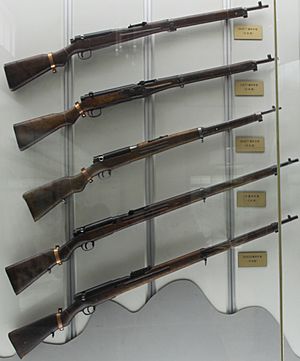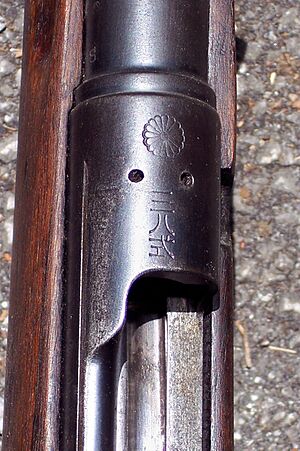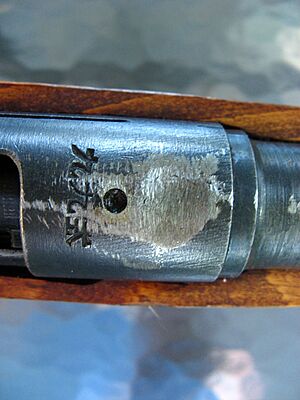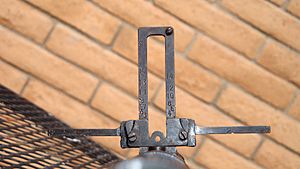Arisaka facts for kids
Quick facts for kids Arisaka rifle |
|
|---|---|

Various Arisaka rifles on display at the Military Museum of the Chinese People's Revolution
|
|
| Type | Bolt-action service rifle |
| Place of origin | Empire of Japan |
| Service history | |
| In service | 1897–1961 |
| Production history | |
| Designer | Arisaka Nariakira Kijirō Nambu |
| Designed | 1897 |
| Variants | Type 30 Type 30 carbine Type 35 Type 38 Type 38 carbine Type 38 sniper rifle Type 44 carbine Type 97 sniper rifle Type 99 Type 99 sniper rifle TERA |
| Specifications | |
| Cartridge | 6.5×50mmSR Type 30 6.5×50mmSR Type 38 7.7×58mm Type 92 7.7×58mm Type 97 7.7×58mm Type 99 |
| Action | Bolt-action |
| Feed system | 5-round internal magazine (reloaded via stripper clip) |
| Sights | Rear: ladder, tangent (Type 35) Front: fixed blade Sniper variants: factory-zeroed scope |
The Arisaka rifle (Japanese: 有坂銃, romanized: Arisaka-jū) is a type of military bolt-action rifle. It was made and used in Japan starting around 1897. These rifles were used until the end of World War II in 1945. The most common models were the Type 38 and the Type 99. The Type 99 used a powerful bullet, similar to a modern .308 Winchester round.
Contents
History of the Arisaka Rifle
The Arisaka rifle was designed by Colonel Arisaka Nariakira (有坂 成章). He later became a lieutenant general and was given the title of baron by Emperor Meiji in 1907.
Over the years, different versions of the Arisaka rifle were made. They changed from using a 6.5mm bullet to a larger 7.7mm bullet. There was even a special version for paratroopers that could be taken apart into two main pieces. This made it easier to carry during airborne operations.
Tests done after the war showed that Arisaka rifles were very strong. They were even stronger than other famous rifles like the M1903 Springfield, Lee–Enfield, and Mauser rifles. Arisaka rifles also used a special type of barrel design called polygonal rifling. This was different from the usual way barrels were made back then.
Some early Type 99 rifles had a folding metal stand called a monopod. This helped soldiers shoot more accurately when lying down. The rear sights on some rifles could also fold out to help shoot at airplanes. Towards the end of World War II, simpler and cheaper versions were made. These "last-ditch" rifles helped provide more weapons quickly. For example, they had simpler bolt shapes and sometimes no handguard on the barrel.
The Arisaka rifle was used by the Imperial Japanese Army and Imperial Japanese Navy. Before World War II, some Arisaka rifles were even used by the British Navy and the Russian Army. Soldiers from Czechoslovakia also used them during the Russian Revolution. Many Arisaka rifles were captured and used by other countries like China, Thailand, and Cambodia.
After Japan surrendered in 1945, they stopped making these rifles and their bullets. This made the Arisaka quickly become old-fashioned. Most Japanese military weapons were thrown into Tokyo Harbor after the surrender. This made it hard to find spare bullets. However, China later made more 6.5mm and 7.7mm bullets for the rifles they had captured.
All official Japanese military rifles had a special 16-petal chrysanthemum flower seal stamped on them. This was the Imperial Seal. On many surviving Arisaka rifles, this seal has been removed or damaged. Historians believe this was done on the orders of General Douglas MacArthur, who was in charge of the occupation forces after the war. This was to show that the rifles no longer belonged to the Emperor.
Most Arisaka rifles with the seal still on them are in Japan. A few were taken as war trophies before the surrender or captured by Chinese forces. Some of these captured rifles were later sent to the United States. Some Type 38 and Type 99 rifles captured by Chinese forces were even changed to use different types of bullets.
Sometimes, the chrysanthemum seals were completely ground off. Other times, they were just scratched or had a "0" stamped on them. This usually happened when rifles were no longer used by the Japanese military. For example, some were given to schools or sold to other countries, like the British Royal Navy during World War I.
Thousands of Type 99 and other Arisaka rifles were brought to the United States by Army soldiers and Marines as war trophies after World War II.
Arisaka Rifle Models
There were several different models of the Arisaka rifle. Each one had unique features or was designed for a specific purpose.
Type 30 Rifle
This was the first rifle in the Arisaka series. It used a 6.5×50mmSR Type 30 bullet. About 554,000 of these rifles were made.
Type 30 Carbine
This was a shorter version of the Type 30 rifle, about 300 mm shorter. About 45,000 Type 30 carbines were built.
Type 35 Rifle
This rifle was officially called the Type 35 navy rifle. It was also chambered for the 6.5×50mmSR Type 30 bullet. Major Nambu Kijirō redesigned it for the Imperial Japanese Navy Land Forces. It had some improvements, like a different rear sight and a special bolt cover.
Type 38 Rifle
Developed by Major Nambu Kijirō, the Type 38 used a 6.5×50mmSR Type 38 bullet. It could also use the older Type 30 bullet. A shorter version was made to be easier to handle.
This was one of the most common Arisaka models. It was designed in 1905 and made until 1942, with about 3,400,000 built.
Type 38 Carbine
This was a shorter version of the Type 38 rifle, also about 300 mm shorter. It was used by support personnel.
Type 44 Carbine
This carbine was based on the Type 38 rifle. It used the 6.5×50mmSR Type 38 bullet. A special feature was its folding spike bayonet. It also had cleaning rods hidden inside the buttstock. It was first made for cavalry soldiers but was also used by other support staff.
Type 97 Sniper Rifle
This was one of the main sniper rifles used by the Japanese military. It was based on the Type 38 rifle and used the 6.5×50mmSR Type 38 bullet. Snipers often used special "reduced charge" bullets for less recoil and noise. This helped them stay hidden. It came with a special 2.5X telescopic sight. About 22,500 were made.
Type 99 Rifle
The Type 99 was the rifle that came after the Type 38. It used a more powerful 7.7×58mm Type 99 bullet.
Designed in 1939, the Type 99 was made and used from 1941 to 1945. It was the most common Japanese rifle during World War II, with 2,500,000 built. It had an improved rear sight and a new front sight. Earlier versions even had special sights to help shoot at airplanes.
Type 99 Sniper Rifle
This was the other sniper rifle used by the Japanese military. It was built using both long and short Type 99 models. It used the powerful 7.7×58mm Type 99 bullet. This larger bullet was less affected by wind, but it had a stronger kick. These rifles came with either a 2.5X or a 4X telescopic scope. Snipers were chosen based on their shooting skills. About 10,000 were made starting in May 1942.
TERA Rifles
This was a small series of rifles that could be taken apart. They were made for Japanese army and navy paratroopers. The main model was the Type 2, based on the Type 99 short rifle. It used the 7.7×58mm Type 99 bullet.
The Type 2 could be broken down into two pieces: the stock and action, and the barrel and handguard. This made it easy to store and carry. About 19,000 TERA rifles were made from 1942 to 1944.
Bayonets
A bayonet is a knife or dagger that can be attached to the end of a rifle.
Type 30 Bayonet
This sword-like bayonet was made at the same time as the Type 30 rifle. It could be used with almost all Arisaka rifles, except for the Type 44 carbine. There were many different versions of this bayonet. It could also be attached to some Japanese machine guns.
Type 35 Bayonet
The Type 35 bayonet was a slightly changed Type 30 bayonet. It was made specifically for the Type 35 rifle. It was almost the same size as the Type 30 bayonet. The main difference was a spring-loaded catch that held it in its scabbard. About 8,400,000 bayonets of this type were made.
Type 44 Bayonet
This spike-like bayonet was permanently attached to the Type 44 carbine. It could be folded under the handguard when not in use. When folded, it did not get in the way of the barrel.
Type 2 Bayonet
The Type 30 bayonet was too long for paratroopers to hide easily. So, the Type 2 bayonet was created. It was a knife-like bayonet, 20 centimeters shorter than the Type 30, with a total length of 32.3 cm. It was mainly used with the Type 2 TERA rifle or the Type 100 submachine gun by Japanese paratroopers. About 25,000 were made.
Important Details About Arisaka Rifles
Old military firearms, especially those from the end of World War II, can be dangerous if fired. This is because some "last-ditch" rifles were made with lower quality materials. Also, some rifles were changed by soldiers who brought them home.
After the war, it was hard to find bullets for Arisaka rifles. So, many rifles were changed to use more common types of bullets. For example, Type 38 rifles were often changed to use 6.5×.257 Roberts bullets. Type 99 rifles were sometimes changed to use .30-06 Springfield bullets. Even though the new bullets might fit, they weren't always perfect.
Today, some companies still make new 7.7×58mm and 6.5×50mm Arisaka ammunition. This allows collectors and enthusiasts to safely use these historic rifles.
| Preceded by Murata |
Imperial Japanese Army service rifle 1898–1945 |
Succeeded by End of the Imperial Japanese Military M1 Garand |
Gallery
See also
 In Spanish: Arisaka para niños
In Spanish: Arisaka para niños












